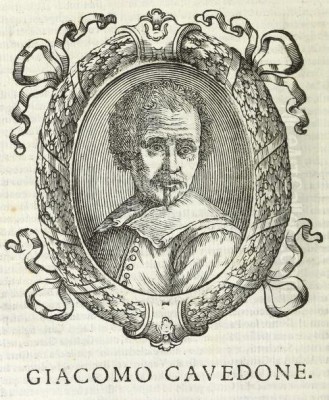
Giacomo Cavedone stands as a significant, if sometimes underappreciated, figure in the vibrant tapestry of Italian Baroque art. Born circa 1577 in Sassuolo, near Modena, his life and career were inextricably linked with Bologna, a city that, during his lifetime, became a crucible of artistic innovation. Cavedone's journey from a promising student to a respected master, and his subsequent tragic decline, offers a poignant narrative of talent, influence, and the cruel vicissitudes of fate. His contributions to the Bolognese School, particularly his adherence to and development of the principles laid down by the Carracci family, cement his place in art history.
Early Life and Artistic Genesis in Bologna
The precise details of Giacomo Cavedone's earliest years in Sassuolo remain somewhat obscure, but it is widely accepted that his artistic destiny was forged in Bologna. He arrived in this bustling artistic center likely in his youth, drawn by the burgeoning reputation of the Accademia degli Incamminati (Academy of the Progressives, or Those Who Are Setting Out). This institution, founded around 1582 by Ludovico Carracci and his cousins, Annibale and Agostino Carracci, was a revolutionary force in Italian art.
The Carracci sought to reform the prevailing Mannerist style, which they perceived as overly artificial and divorced from natural observation. Their academy emphasized a return to the study of nature, the human form, and the great masters of the High Renaissance, such as Titian, Veronese, and Correggio, while also absorbing the dramatic naturalism of contemporaries like Caravaggio, albeit with a more classical restraint. It was within this intellectually stimulating and artistically rigorous environment that Cavedone began his formal training.
Under the Wing of the Carracci
Cavedone's talent quickly became apparent, and he is documented as a pupil primarily of Ludovico Carracci, the cousin who remained in Bologna to head the Accademia while Annibale and Agostino eventually moved to Rome. Ludovico's influence on Cavedone was profound and enduring. He instilled in his student a deep appreciation for strong draughtsmanship, dynamic composition, and a rich, often somber, palette. Cavedone also absorbed lessons from Annibale Carracci, whose classicism and powerful figure drawing were legendary.
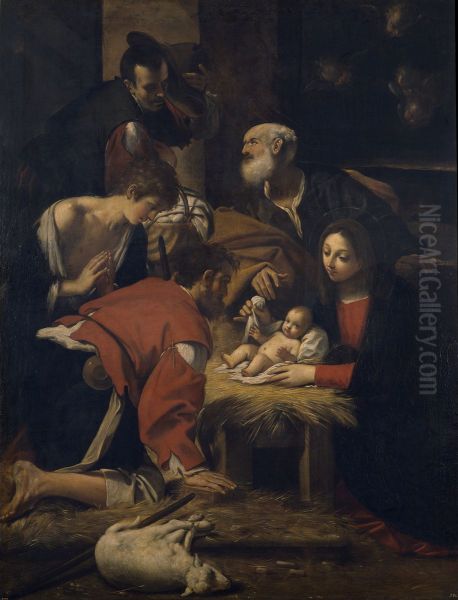
The young artist became one of Ludovico's most trusted assistants, collaborating on numerous significant commissions in Bologna. This apprenticeship provided Cavedone with invaluable practical experience, allowing him to master various techniques, from large-scale fresco painting to intimate oil on canvas works. His early style reflects a diligent absorption of the Carracci ethos: a commitment to verisimilitude, an ability to convey genuine human emotion, and a mastery of light and shadow to create dramatic and engaging narratives.
Artistic Style and Defining Characteristics
Giacomo Cavedone's mature style is characterized by a robust naturalism, often imbued with a tender, melancholic piety. He excelled in depicting religious subjects, which formed the bulk of his oeuvre, responding to the Counter-Reformation's call for art that was clear, emotionally resonant, and doctrinally sound. His figures are typically solid and well-modelled, possessing a tangible physicality.
A key feature of his work is his adept use of chiaroscuro, the dramatic interplay of light and dark. This was a hallmark of the Baroque era, and Cavedone employed it skillfully to heighten the emotional intensity of his scenes and to focus the viewer's attention. He was particularly influenced by Ludovico Carracci's "brunetto" style, characterized by warm, earthy tones and deep shadows, which lent a sense of gravity and intimacy to his paintings. His color palette, while often subdued, could also incorporate rich, jewel-like tones, especially in his earlier works.
Cavedone was also a gifted draughtsman. Numerous preparatory drawings survive, executed primarily in black chalk, often heightened with white on colored paper, or with pen and brown ink. These studies reveal his meticulous approach to composition and his careful observation of anatomy and expression. They underscore the Carracci emphasis on disegno (drawing and design) as the foundation of painting.
Notable Works and Major Commissions
Throughout his career, Cavedone produced a significant body of work, much of it for churches and religious institutions in Bologna and the surrounding region. While a comprehensive list is extensive, several key works highlight his artistic prowess.
One of his most important early commissions was for the Arrigoni Chapel in the church of San Paolo Maggiore in Bologna. Here, between 1613 and 1614, he executed several significant paintings, including the powerful Adoration of the Shepherds and the Adoration of the Magi. These works showcase his mastery of complex multi-figure compositions and his ability to convey a sense of awe and reverence. A surviving study, Head of a Bearded Man, likely a preparatory drawing for one of the shepherds in the Arrigoni Chapel, demonstrates his skill in capturing individual character and texture with remarkable sensitivity.
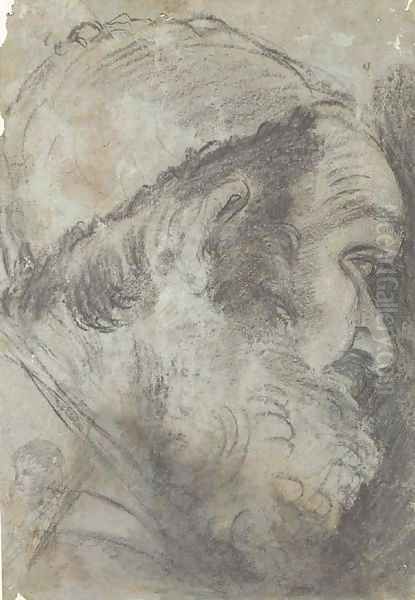
Other significant religious paintings include The Prophet Isaiah, a work that would have demonstrated his capacity for depicting venerable, authoritative figures, and various depictions of the Madonna and Child. These Madonna paintings often convey a tender intimacy, reflecting a personal piety that resonated with contemporary viewers. The Holy John (or St. John the Baptist), likely dating to around 1600, would have showcased his ability to render youthful saints with a combination of idealization and naturalism.
His St. Stephen, depicting the first Christian martyr, often shown with the stones that were the instruments of his death, provided an opportunity for Cavedone to explore themes of faith and sacrifice, central to Baroque religious art. A work titled Christ and the Doctor (likely Christ Disputing with the Doctors in the Temple) would have allowed him to tackle a narrative scene requiring a range of ages and expressions, demonstrating Christ's precocious wisdom.
Many of Cavedone's altarpieces and frescoes adorned the churches of Bologna, contributing to the city's reputation as a major center of Baroque art. His ability to work on a large scale, creating visually compelling narratives that could be understood from a distance, was highly valued.
Roman Interlude and Broadening Horizons
Like many ambitious artists of his time, Cavedone spent a period in Rome, likely between 1610 and 1612. During this time, he is reported to have worked as an assistant to Guido Reni, another luminary of the Bolognese School who had achieved great success in the papal city. Reni, though also a product of the Carracci academy, developed a more classical and graceful style, characterized by lighter palettes and idealized figures.
Exposure to Reni's work, and to the artistic ferment of Rome – with its ancient ruins, High Renaissance masterpieces by Raphael and Michelangelo, and the revolutionary naturalism of Caravaggio – undoubtedly broadened Cavedone's artistic horizons. While his fundamental style remained rooted in the teachings of Ludovico Carracci, his Roman experience may have contributed to a greater refinement in his figures and a more nuanced handling of color in certain works.
Leadership and Continued Activity in Bologna
Upon his return to Bologna, Cavedone's reputation was firmly established. He continued to receive important commissions and played an active role in the city's artistic life. Following the death of Ludovico Carracci in 1619, Cavedone, as one of his most accomplished pupils, is believed to have taken on a leading role, perhaps even serving as head (caposindaco) of the Accademia degli Incamminati for a time. This would have placed him in a position of considerable influence, responsible for guiding the next generation of Bolognese artists.
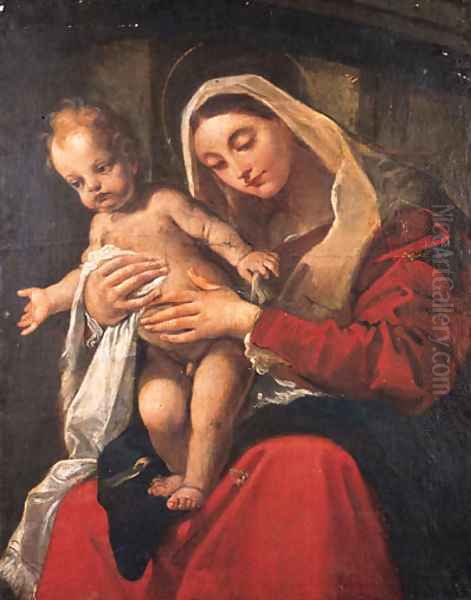
His works from this period demonstrate a mature command of his craft. He continued to produce powerful altarpieces and devotional paintings, solidifying his status as one of Bologna's foremost painters. His style, while consistent, showed an ongoing engagement with the evolving artistic trends of the early 17th century.
The Artistic Milieu of Bologna: Contemporaries and Connections
Giacomo Cavedone operated within a rich and competitive artistic environment. Bologna in the late 16th and early 17th centuries was a hub of creativity, largely thanks to the Carracci. Besides his direct mentors – Ludovico Carracci, Annibale Carracci, and Agostino Carracci – Cavedone's contemporaries included a host of talented painters who had also passed through the Accademia.
Guido Reni (1575-1642) was perhaps the most internationally famous of these, achieving immense success with his elegant, classical style. Cavedone's brief association with him in Rome indicates a professional connection. Francesco Albani (1578-1660), another prominent Carracci pupil, was known for his idyllic mythological and religious scenes, often featuring charming putti and graceful female figures. Domenichino (Domenico Zampieri, 1581-1641) was celebrated for his clarity of composition and emotional restraint, becoming a leading exponent of Baroque classicism.
Giovanni Francesco Barbieri, known as Guercino (1591-1666), though slightly younger and initially developing a distinct, highly dramatic style, also became a dominant force in Bolognese and Roman art, eventually adopting a more classical manner. Giovanni Lanfranco (1582-1647), another Carracci alumnus, was renowned for his dynamic and illusionistic dome frescoes, particularly in Rome and Naples.
Among Cavedone's fellow students under Ludovico was Francesco Camillo (often known as "il Camillino"), who would have shared a similar foundational training. Later artists like Emilio Savonanzi (1580-1666), who also trained in the Carracci circle, showed stylistic affinities that suggest the pervasive influence of the school, an influence Cavedone himself helped to perpetuate. The attribution of some drawings by Fra Semplice da Verona (c. 1589-1654) to Cavedone at times also points to the interconnectedness and stylistic dialogues occurring within the broader artistic community influenced by Bolognese trends.
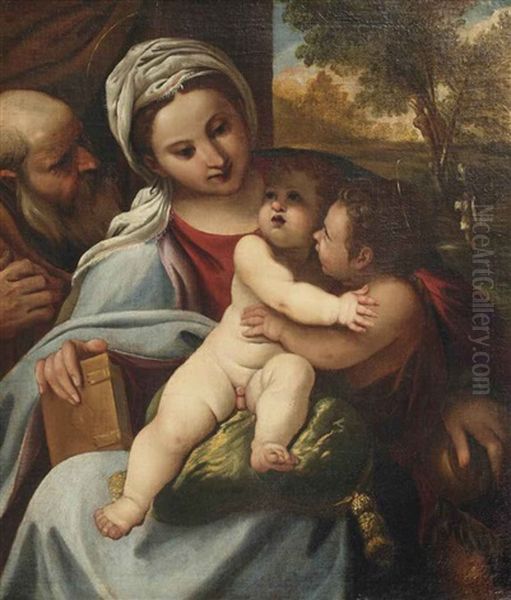
The artistic landscape was also shaped by the legacy of earlier masters. The Venetian school, with painters like Titian, Veronese, and Tintoretto, was a crucial source of inspiration for the Carracci and their followers, particularly for their rich color and dynamic compositions. Correggio, from nearby Parma, was admired for his sfumato and graceful figures. And, of course, the towering figure of Caravaggio, though not Bolognese, cast a long shadow with his revolutionary naturalism and dramatic use of light, prompting responses and adaptations from artists across Italy, including those in Bologna.
A Series of Tragedies and Artistic Decline
The promising trajectory of Cavedone's career took a devastating turn in the 1620s. A series of personal misfortunes began to overshadow his artistic life. In 1623, he suffered a serious accident, falling from scaffolding while working in a church, possibly San Salvatore. This incident reportedly left him with physical ailments that may have hampered his ability to undertake large-scale commissions.
A far greater tragedy struck in 1630. A devastating outbreak of the plague swept through Bologna, claiming countless lives, including those of Cavedone's wife and children. The emotional and psychological impact of such profound loss on the artist can only be imagined. Contemporary accounts suggest that these events, coupled with his earlier injuries, led to a significant decline in his artistic output and a withdrawal from professional life.
Some sources indicate that he became increasingly melancholic and perhaps even suffered from mental health issues. His financial situation deteriorated, and the once-respected master found himself struggling with poverty in his later years. This period of his life is marked by a poignant silence in terms of major artistic production, a stark contrast to his earlier prolificacy.
The Unfortunate Episode of Nazi-Looted Art
Centuries after his death, Giacomo Cavedone's name resurfaced in connection with a darker chapter of 20th-century history. During World War II, two pastel drawings by Cavedone were among the artworks looted by the Nazis from the collection of Arthur Feldmann, a Jewish lawyer and art collector in Brno, Czechoslovakia. Feldmann perished in the Holocaust.
Decades later, these works were identified and, following a complex process of restitution, were returned to Feldmann's heirs. This incident, while not directly related to Cavedone's life, serves as a reminder of how artworks can become entangled in historical events far removed from their creation, and highlights the ongoing efforts to redress injustices of the past.
Final Years and Death
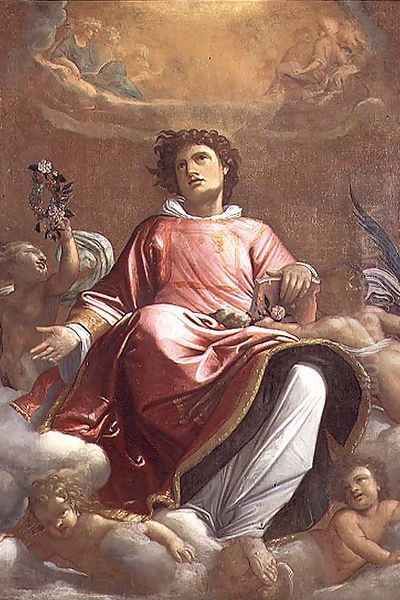
The last decades of Giacomo Cavedone's life were marked by obscurity and hardship. Having lost his family, his health, and seemingly his artistic drive, he lived in poverty. He died in Bologna in 1660, the same year as his contemporary Francesco Albani. His passing went largely unnoticed by the art world that had once celebrated his talents. It was a somber end for an artist who had contributed significantly to the artistic vibrancy of his city.
Legacy and Art Historical Assessment
Despite the tragic end to his career, Giacomo Cavedone's artistic contributions remain significant. He was a key figure in the second generation of the Bolognese School, faithfully upholding and disseminating the artistic principles of the Carracci. His work exemplifies the transition from the late Renaissance to the full-blown Baroque, characterized by its emotional intensity, naturalism, and dramatic use of light.
His paintings, particularly those in Bolognese churches like San Paolo Maggiore, stand as testaments to his skill and piety. His numerous drawings are highly valued by collectors and scholars, offering insights into his working methods and his mastery of the human form. While he may not have achieved the same level of international fame as some of his contemporaries like Guido Reni or Guercino, Cavedone was a highly accomplished painter who played a vital role in the artistic ecosystem of Bologna.
Art historians recognize him as an important link in the chain of Bolognese painting, an artist who absorbed the lessons of his masters and, for a significant period, produced works of considerable power and beauty. His adherence to the Carracci reforms helped to solidify a style that would influence painters in Bologna and beyond for decades. Though his later life was marred by tragedy, his earlier achievements ensure his place as a respected master of the Italian Baroque. His story is a compelling reminder of the human element in art history – of talent nurtured, of success achieved, and of the profound impact that personal adversity can have on a creative spirit.